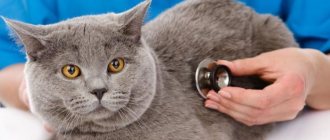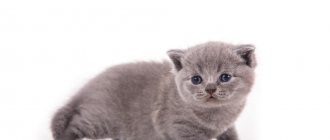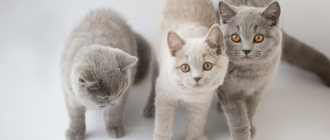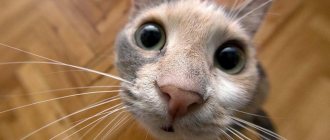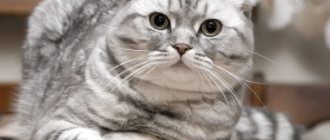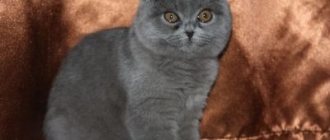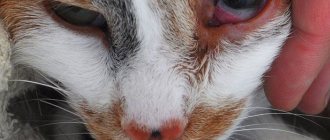Snoring is almost as common among cats as it is among people. Therefore, the characteristic sounds made by a pet during sleep are not always an alarming sign of serious pathologies. There are breeds that are predisposed to snoring due to the specific structure of the muzzle and olfactory organs in particular. There are cats that snore on their own, even though it doesn't happen that often. It is difficult to count all the reasons why a cat snores. In this article we will try to cover all aspects of cat snoring, its painful and healthy sides.
The cat snores
Genetic predisposition
Snoring among people and even among dogs is a normal, common occurrence. Cats snore much less often in their sleep, but it does happen. This most often occurs with breeds with a flattened muzzle. Such animals have short sinuses in the nose, which leads to a “source of noise” during sleep.
This phenomenon is commonly called brachycephalic syndrome. Snoring breeds include:
- Persians;
- Briton and Scottish cats;
- Exotic cats and others.
Just because your pet has a flattened face does not mean that he cannot get sick. Observe the animal and if you think the temple is abnormal, consult your veterinarian immediately.
Brachycephalic syndrome can manifest itself in three types. Owners of brachycephalic breeds should be well versed in their characteristics.
One of the most common symptoms is a stenotic nose. It is represented by small nostrils through which air flows at a lower speed. Such cats should not lead an overly active lifestyle and should not be exposed to stress that can cause shortness of breath or heart failure.
Another irregular structure of the muzzle is an elongated soft palate . The cat's palate sags down and prevents air from passing through.
Cases of tracheal stenosis are not uncommon. This means that the tracheas of breeds at risk are narrowed in places. This structure makes them vulnerable and is a pathology.
Cats of other breeds may also snore and wheeze in their sleep. If this process is accompanied by grunting, tail wagging and limb twitching, this is normal.
ATTENTION! Most likely, the pet is simply having an emotional dream, or he has taken an uncomfortable body position.
Normal cat condition
If your feline pet sniffles, but does not express any pain, his behavior has not changed, he plays, eats well, you need to examine the animal:
- if the nasal mucosa is pink, then the body receives enough oxygen;
- there is no discharge from the nose, which means a cold is excluded;
- Light pressure over the entire back will help determine whether there are or are no areas of pain.
When your cat sniffles, she also scratches her nose with her paws and sneezes; perhaps she just has an allergy, which will disappear after the allergen is eliminated.
Periodic snoring is normal for humans and animals.
Signs and types of snoring
If your animal has difficulty breathing unexpectedly, you should go to the veterinary clinic. The doctor will ask a lot of questions, so take a history of your breathing disorder along the way. It consists of the following points:
- Age;
- Food (homemade food or feed);
- Animal activity and lifestyle in general;
- Underweight or overweight (each breed has its own norms);
- Duration and frequency of snoring, as well as when it occurs (during inhalation or exhalation);
- Do the mucous membranes change during sleep or after it;
- Have there been any injuries (especially to the head and muzzle);
- Associated symptoms and any changes in behavior.
Alarming symptoms include high fever, decreased appetite and apathy, as well as vomiting and loose stools.
It will also be good if you have already identified the type of snoring. It is quite possible to do this without medical equipment, the main thing is to be able to understand them. There are 4 types in total.
| Type | What is it characterized by? |
| Dry | An inexperienced person will only be able to notice this type when exhaling. It is very similar to hissing and indicates swelling of the bronchi or narrowing of the arteries. |
| Wet or bubbly | Sounds are heard both during inhalation and exhalation, similar to “overflowing” or the collapse of bubbles. This type of snoring is accompanied by increased volume; you can hear it even if you are in another room. It indicates the presence of sputum. |
| Crackling snoring (creptating) | Appears at the moment of exhalation, as a result of the straightening of the stuck together alveoli. |
| Inspiratory | Sounds like a whistling or hissing sound. Experts associate it with swelling of the airways. |
A correctly identified type of cough will help a specialist quickly make a diagnosis and begin treating the animal.
Comprehensive diagnostics
Cat owners should remember that any pathology has several manifestations at once, which make it possible to more accurately determine the disease. If you don't notice any changes in your pet other than snoring, there is most likely no cause for concern. Of course, an extra trip to the vet is never harmful.
If you have any doubts about your cat's health, take it to the veterinarian, describing in detail your pet's snoring.
However, cats whose snoring is accompanied by other negative symptoms that are not immediately noticeable and sometimes almost completely unnoticeable deserve special attention. Less obvious manifestations of a possible disease include:
- General weakness, apathy;
- Lack of appetite;
- Temperature increase;
- Digestive disorders: diarrhea, diarrhea, constipation;
- Shortness of breath during free time from sleep, difficulty breathing;
- Frequent sneezing;
- Cough.
When diagnosing the disease, you should pay attention to the painful manifestations that accompany snoring.
Taking an anamnesis
If you have checked one or more items from the above list, you should collect a preliminary medical history to prepare for the veterinarian’s upcoming questions. The anamnesis includes the following information:
- Age and basic habits;
- Accurate weight;
- The time of occurrence of snoring and the possible reasons with which the owner associates it;
- The specificity of the extraneous sounds causing concern - whether they are heard during inhalation, exhalation, or both;
- Paleness or, conversely, inflammation of the mucous membranes during sleep or immediately after waking up;
- The presence of traumatic brain injuries or injuries that affected the muzzle or some parts of it;
- The manifestation of indirect symptoms indicating the painful condition of the pet, indicated above.
A comprehensive history will help the veterinarian quickly understand the pet’s condition.
Diseases
There can be many reasons why a kitten snores and wheezes. Let's take a closer look at the most common of them:
- Swelling of the larynx. Most often it occurs as a result of an allergic reaction to any food product or object that has entered the cat’s throat. It causes inflammation. To avoid this, you need to eliminate the allergen from your home. If laryngeal edema appears due to other diseases, the doctor selects individual therapy for the animal, which increases its resistance to the irritant;
- Asthma. This is the most misunderstood disease in cats. It is influenced by genetics and the breed of the animal. Asthma is accompanied by shortness of breath and severe coughing, which also occurs during wakefulness;
- Urolithiasis disease. The following signs indicate its presence: head tilted forward, hunched posture, difficulty urinating, accompanied by pain and blood, going to the toilet past the tray. Young males are most susceptible to it, especially those who have undergone castration and removal of the gonads.
- Parasites. Animal lovers should know that roundworms and other parasites live not only in the gastrointestinal tract, but also in other internal organs, including the lungs. The most common of them are helminths. Only medical tests will accurately indicate the presence of parasites and their types.
- Pneumonia or bronchitis. It is not difficult to notice the symptoms. This is usually a cough that leads to vomiting and blueness of the animal’s gums and palate.
- Heart failure. Many factors can lead to its occurrence, from heart disease to serious stress. Some breeds are at risk. Among them are sphinxes and British ones. Overweight animals are most likely to suffer from heart failure.
- Obesity. Fat lazy cats often cause affection among animal lovers, however, you should not allow your pet to experience such a state. It is fraught with a heavy load on the heart muscles, which simply cannot cope with such weight.
- Injuries. Cats are energetic animals that cannot sit still. Often their active lifestyle leads to injuries such as concussions, respiratory damage and rib fractures.
- Foreign body. Small objects can get stuck in your pet's throat or nasopharynx. Pieces of food are especially dangerous, as they can not only block the respiratory tract, but also fester, which will lead to inflammation and death of the animal.
Heart failure is difficult to determine, since the symptoms are similar to asthma and pneumonia: wet snoring, shortness of breath, a change in the color of mucous membranes to blue. All this can lead to fainting or blood clots, which invariably leads to paralysis of the hind legs.
Cats of the British breed, animals that have undergone sterilization and, in general, all animals living at home are prone to obesity. It is important to choose the right diet for your pets and provide them with sufficient physical activity.
The reason why a cat snores loudly when breathing
The respiratory system of cats is similar in structure to that of humans. They, just like humans, can sigh, grunt and even snore. If a cat sniffles not only in his sleep, this may be a symptom of an illness.
If you don’t understand why your cat wheezes when breathing, then most likely she has rhinitis or a runny nose.
The animal begins to sniffle as a result of inflammation of the nasopharyngeal mucosa. This happens due to hypothermia or a cold.
The respiratory system of cats is similar to humans
A pet's runny nose often occurs as a result of exposure to chemicals. Rhinitis can be a consequence of any previous disease.
If a cat sniffles, you need to monitor it; the sick pet constantly rubs its nose with its paws, often sneezes, and has difficulty breathing.
In addition, the pet looks apathetic, there is exhaustion, and the development of conjunctivitis.
In case of a cold or rhinitis, treatment must be carried out to avoid negative consequences.
Danger
There are signs that indicate an urgent trip to the doctor. The most dangerous of them is when the animal suffocates while sleeping or awake . Mucus or other fluid from a cat's nose or swelling on the face are symptoms that require immediate consultation with a specialist.
IMPORTANT! Also, you should pay attention to your pet’s hoarse or excessively high-pitched voice.
If a cat cranes her neck as if something is preventing her from breathing, there may be a foreign object in her nasopharynx or throat. Urgent surgical intervention is necessary before the foreign body has yet caused significant harm to the animal.
Causes of nasal congestion in cats
Nasal congestion in cats is not an independent disease, but rather refers to signs of both mild ailments and serious and dangerous pathologies. The sense of smell is the most important sense for these animals, so if the first symptoms of a runny nose, difficulty breathing or excessive nasal discharge appear, you should consult a veterinarian. There can be many causes of the disease, but the most common are the following.
Cold
The most obvious cause of nasal congestion is, of course, a cold. A cat can catch a cold as a result of prolonged exposure to a draft or due to simple hypothermia. As a rule, in these cases symptoms such as general lethargy, weakness and tearfulness also appear. Sometimes the animal's eyes can even fester.
Viral or bacterial disease
Small kittens that have not yet developed a strong immune system are most susceptible to viral and bacterial diseases. At the same time, adults are also not immune from them. A cat can pick up the virus both during communication with unhealthy relatives and as a result of contact with contaminated objects: after sniffing outdoor shoes or rubbing parts of the body against them.
Only a doctor can identify a viral or bacterial disease
Viral infectious diseases found in cats:
- flu (cat);
- infectious rhinitis (the causative agent is most often the herpes virus).
Bacterial infectious diseases include:
- mycoplasmosis;
- pasteurellosis;
- chlamydia.
Only a correct examination will allow us to establish the cause of the disease and prescribe treatment, so the primary task is to diagnose the disease.
Allergy
Sometimes nasal congestion can be caused by an allergic reaction. Pedigree animals are more susceptible to various types of allergies. Most often, pets begin to snort and sneeze when in contact with:
- plant pollen;
- dust;
- hot steam;
- food;
- particles of household chemicals;
- flavorings.
If the consistency of the animal's nasal discharge is liquid and transparent, then most likely the cause of nasal congestion is an allergic reaction. A side symptom of the disease is watery eyes. In this case, it is necessary to identify the allergen and remove it from the living space. If you manage to guess and neutralize the provoking factor, then in the near future the cat will be able to feel significant relief. In addition, antihistamines can be used as an auxiliary measure for a speedy recovery of the animal (allowed to be used only after being prescribed by a specialist).
Parasite infestation
Nasal congestion and difficulty passing air through the respiratory system in cats can also occur as a result of infection with helminths - parasites whose habitats include the lungs of the animal. They can provoke diseases such as pneumonia and rhinitis.
Decreased immunity
With a weakened immune system, the animal is at greater risk of nasal congestion and runny nose. In this case, the cat will have a light-colored mucus discharge on his nose, and his body temperature will also increase. The pet will become lethargic, curl up in a ball and lie down, not even reacting to food.
Decreased immunity causes general lethargy
Foreign body entry
Cats are active and curious creatures. This character trait increases the risk of injury during games - objects getting into the respiratory tract through the mouth or accidentally inhaling small pieces of grass and objects stuck in the nasal cavity. In this case, the animal may exhibit loud snoring and begin to wheeze and snort.
Important! If the pet is unable to independently remove the foreign body that is blocking the air supply, then snot along with blood may begin to come out of its nose. In this situation, the animal will need emergency care, otherwise tissue rot may begin, which will significantly complicate treatment.
Inflammatory processes
Inflammatory processes of the teeth and gums - chronic inflammation, the formation of polyps and adenoids in the nasal passages - can also lead to nasal congestion in cats. This is most common in Persian cats.
Treatment at the veterinary clinic
If you are unlucky enough to encounter a similar problem, be prepared for a full examination of your pet. The veterinarian analyzes the condition of the throat and nasopharynx and, if necessary, prescribes x-rays and blood tests. Some examinations involve putting the cat into medicated sleep.
When the cause of the disease becomes clear, treatment is prescribed. For each individual case there are different prescriptions: pills, injections, ear swabs, droppers, various kinds of diets and even operations. It all depends on the severity of the case.
For example, in case of obesity, it is enough to switch the cat to specialized food. With hyperplasia of the soft palate, the owner should put up with snoring. Surgery is performed only in cases where there is an immediate risk to the health or life of the cat. Parasitic infestation is treated by taking special tablets.
ATTENTION! To prevent parasites from appearing in your cat’s body, give him preventive tablets.
Cats with asthma are given steroids based on how advanced the disease is.
A healthy animal is the key to family peace. Remember that physiological snoring cannot be cured . But if you see something big in him, don't delay going to the veterinary clinic.
Possible diseases and pathologies
When your pet snores constantly, or very often, it may be a symptom of one of the following conditions:
- swelling of the larynx; may be caused by allergies, or the presence of foreign objects in the respiratory system;
- urolithiasis disease; snoring is sometimes accompanied by wheezing;
- the presence of worms, which may even be present in the respiratory system;
- asthma;
- rhinitis;
- pneumonia and bronchitis;
- heart failure; along with wheezing, a cough and blue discoloration of the mucous membranes can be observed;
- respiratory tract infections;
- obesity.
Preventive measures and prognosis
To prevent the immediate death of a pet, it is important for the animal owner to carefully monitor the condition and behavior of the cat. In case of any changes, you should contact a veterinary clinic, where the necessary examinations will be carried out, with the help of which it will be possible to identify health problems in your pet. In addition, the owner needs to protect the cat from various injuries, as well as infection.
As for the prognosis, doctors say that the outcome is ambiguous. The veterinarian can assess the likelihood of improvement in the cat's condition using the modified Glasgow Coma Scale. The doctor evaluates reflexes during a neurological examination, after which scores are calculated. Using this scale, it is possible to most accurately predict the survival of a pet.
What symptoms would indicate a problem?
Symptoms of coma in both a kitten and an older pet can be noticed not only by a veterinarian, but also by the pet owner. If a cat is unconscious for 2-3 days, its body is colder than usual, there are no reflexes, but breathing remains, we are talking about a coma. In this case, rigor mortis is absent.
If the cat has not yet fallen into a coma, the owner should be alert to the following signs of imminent death:
- loss of appetite;
- stool mixed with blood;
- darkening of biological fluid;
- breathing problems;
- decreased blood pressure;
- unpleasant odor from the pet;
- decrease in body temperature.
Return to contents
How to treat an animal
Pets need to be looked after like small children. If a cat has a stuffy nose, it needs to be helped to breathe normally, otherwise the animal will not be able to eat properly and will become even more ill.
But medications intended for improving the health of people are not suitable here - pharmacology has developed special medications for cats, taking into account physiological characteristics.
But the plan of therapeutic measures is completely identical:
- for infectious diseases of a bactericidal nature, the pet will be prescribed a course of antibiotics;
- anti-inflammatory and antipyretic drugs are also used in therapy;
- for allergic rhinitis, avoid contact with the irritant and use antihistamines;
if the cause of a runny nose lies in infestations, deworming is carried out;- when rhinitis is the result of a systemic disease or dental problems, draw up a comprehensive treatment plan and follow it;
- Vasodilator drops will help ease your cat's breathing.
Sometimes doctors prescribe inhalations with essential oils. But here you need to take into account the pet’s predisposition to allergies - a strong smell can provoke swelling of the nasopharynx.
In special cases, surgical intervention will be required. These include injuries, penetration of foreign bodies into the nasal cavity, and neoplasms.
Age characteristics
When choosing medications for the treatment of runny nose in cats, you need to focus not only on the specifics of the medications (human or feline).
It is also important to consider the age of the pet. For example, the concentration of immunomodulators in nasal drops intended for adult animals is dangerous when using such drugs for babies.
All medications used in the treatment of nasal congestion are selected exclusively by a veterinarian. He also prescribes the dosage depending on the animal’s age and physiological characteristics. Pregnant and lactating cats require a special approach.
Home therapy
In addition to the main treatment, cat owners are advised to rinse their pet's nose at home.
This should be done with a syringe without a needle, a pipette, using saline solution or ordinary boiled water. This allows you to soften the crusts formed on the mucous membrane, which are then easily removed with cotton wool.
In case of severe inflammation, it is recommended to supplement the rinse with chamomile decoction. But this is done after the crusts and the bulk of the accumulated fluid are removed from the sinuses.
Only after the described procedures, nasal drops are instilled into the pet’s nose..
Thanks to their narrowing effect, the swelling will quickly subside, the animal will stop sniffling and begin to breathe fully.
It is recommended to fight colds by warming up. A bag of warm sand is placed on the cat’s nose and held there for 15-20 minutes. But if the animal has an elevated body temperature, this method of dealing with a runny nose is excluded.
Artificial respiration and cardiac massage
If a cat's brain is deprived of oxygen for several minutes due to cardiac or respiratory arrest, irreversible brain damage occurs. This is one of the few situations where timely provision of first aid can save an animal’s life. Artificial respiration and cardiac massage must be carried out in case of loss of consciousness as a result of suffocation and electric shock, after rescuing a cat from water, in case of heart failure, after inhalation of smoke, poisoning, blood loss, concussion, fainting, shock, diabetes, that is, in various conditions that threaten life of a cat. Heart massage should be performed in the same rhythm with breathing from mouth to nose. However, do not use any of these procedures until it is obvious that the cat is unconscious and will die without your help.
If your cat has stopped breathing, it is necessary to give her artificial respiration. To do this, lay it on its side. Clear her airway and extend her tongue forward. Any object blocking the throat or nose must be removed. Close the animal's mouth, clasping the muzzle with your hand, put your lips against the cat's nose and blow air until you notice an expansion of the chest (Fig. 32).
Rice. 32. Artificial respiration
Then move your lips away and let her lungs exhale. Repeat the procedure 20-30 times within a minute. Check your pulse every 10 seconds to make sure your heart is beating. If there is no heartbeat, perform both cardiac massage and artificial respiration. The most important thing is to contact your veterinarian as soon as possible.
Heart massage is done like this. Feel for a heartbeat or find a pulse. Apply pressure to your gums and see if blood flows back to the area you pressed after you remove your finger. If cardiac arrest occurs, the following measures must be taken. Place the animal on its side so that the head is lower than the body. Grab your entire chest with your palm just below your elbow joints. Place your other hand on the cat's back (Fig. 33).
Rice. 33. Heart massage
Squeeze your chest wall tightly, directing pressure toward your neck. Be energetic but careful. If your cat has broken ribs, perform movements carefully and carefully so that the damaged ribs do not put pressure on the heart. Repeat pumping movements with a rhythm of 100 times per minute, making quick elastic thrusts. Thus, perform cardiac massage for 15 s, mouth-to-nose artificial respiration (2 exhalations into the cat’s nose) for 10 s. Continue cardiac massage until a pulse appears, then perform artificial respiration. Contact your veterinarian as soon as possible.
Coma is rare in cats, but is considered a very dangerous phenomenon. In addition to the fact that the animal loses consciousness, in a comatose state there is a fading of reflexes, sometimes their complete disappearance, disruption of the respiratory process and thermoregulation. If these emergencies are noticed, it is important for the pet owner to take the pet to the vet immediately, as coma can cause the cat's death.
Cat has a runny nose
Often cat owners are faced with a pet disease such as rhinitis . The cat suffers from a runny nose and a stuffy nose, because it loses its unique ability to accurately and quickly navigate the environment and recognize danger. What manifestations of rhinitis can be noticed?
- The animal not only has difficulty breathing through its nose, it cannot run or play calmly. It also becomes more lethargic, detached, loses appetite, and looks depressed.
- You can see the cat scratching its nose with its paw, fiddling with it, trying to clear it of congestion.
- Sometimes the temperature rises, even up to 39 degrees. If you touch your pet's nose, you can notice how hot it has become.
- Another sign of rhinitis can be conjunctivitis. It is necessary to wash the animal’s eyes so as not to aggravate the inflammation.
How does a coma manifest?
Symptoms in a cat of coma caused by kidney failure, liver failure, or diabetes mellitus always have characteristic features.
The animal falls into a lethargic state for several days, and body temperature decreases. The cat stops responding to external stimuli - noise, screams, and respiratory activity becomes very weak.
A characteristic difference between a comatose state in a cat and death is the absence of rigor mortis.
Most often, diabetic coma is diagnosed in cats, which develops quite slowly, because from the onset of the pathological process to the complete loss of consciousness by the animal, it takes from several days to one week.
There are several characteristic periods of hyperglycemic coma:
- Precomatose - characterized by increased thirst and urine output, a sharp decrease in total body weight, nausea and eruption of gastric contents. There is general weakness in the cat, itching on the skin, an increase in ketone bodies in the general analysis, and then passes into the stage of incipient coma.
- An incipient coma is characterized by increased vomiting with blood clots, increased thirst, the appearance of a strong smell of acetone from the mouth, painful sensations in the abdominal area, and dehydration.
- Coma is the final stage, which is characterized by the presence of dry skin, softening of the eyeballs, and a decrease in body temperature to critical levels. If the temperature rises, one should suspect the presence of an associated infection. The breathing of a sick animal changes, a dark brown coating is detected on the tongue, the muscles are relaxed, the pulse is rapid and incomplete.
In addition, signs of the onset of coma in a cat are:
- A sharp decrease in pressure in the arteries. This is primarily due to disturbances in the functioning of the myocardium, atrial fibrillation, as well as extrasystole of the ventricular type;
- Increased excretion of urine with an increased content of ketone bodies, proteins and glucose, and upon microscopic examination, red blood cells and casts are noted in the urine.
- Changes in blood test - there is an increased content of ketone bodies, protein particles, creatinine and urea. In addition, the erythrocyte sedimentation rate increases, and leukocytosis is also noted.
- A change in the level of immunoreactive insulin, accompanied by dehydration, loss of electrolytes, a decrease in sodium particles and an increase in potassium particles. As a consequence, disruption of the sodium-potassium pump leads to disruption of myocyte function.
